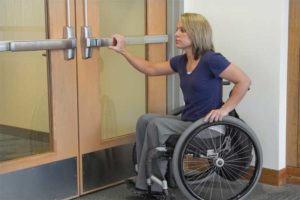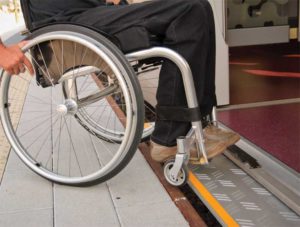Accessible doors: Openings to opportunity
by sadia_badhon | December 4, 2020 9:03 am
 [1]
[1]By Samantha Proulx, CET
A lot of readers are probably capable of using a door and its hardware without giving it much thought, but there are so many others who choose not to or may not be able to go somewhere because the door prevents access in one way or another—the door(s) may be difficult to find, not large enough to fit through, too heavy to open, or it closes too fast. Let me jog your memory—remember the time your hands were full while attempting to go through a door or set of doors with a stroller full of kids, mobility device, bicycle, golf bag, or you finally decided to leave the house to get some groceries, and all of a sudden the door landing feels too small, the vestibule is too tight, the doors are super heavy (one arm on one door while you acrobat a limb to hold the other) as the door(s) close at lightning speed behind you. Now you are frustrated, cursing, and wishing the entire setup was equipped with a power door operator or designed properly in anticipation of people passing through doing real life things. Well, you are not alone.
This article takes into consideration Articles 3.8.3.6, “Doorways and Doors,” and 3.3.1.19, “Transparent Doors and Panels,” of the 2015 National Building Code (NBC), and gives a sneak preview of proposed changes to the 2020 NBC concerning those articles, unless otherwise specified (‘proposed changes’ refer to the amendments being considered and not yet confirmed or in effect). The Ontario Building Code (OBC) has also been used as a comparison code to provide readers an example of where a provincial code may have more restrictive accessible requirements for doors. Although not entirely addressed in this article, the Canadian Standards Association (CSA) B651-18, Accessible Design for the Built Environment Standard, is another great reference for accessible door guidelines NBC gives design professionals the option to comply with, and also forms the base for some of the more meaningful access features outlined in the Rick Hansen Foundation Accessibility Certification (RHFAC) survey criteria if you are looking to get certified down the road.
 [2]
[2]When we approach a door, we need to be able to find it, open it, travel through it, and close it, all while doing it safely and easily, and with minimal fatigue. In the author’s opinion, there are six critical features associated with a doorway—appearance, identification, approach, operation, passage, and protection. Some may argue seven, if security is included as a standalone feature.
Appearance
When we approach a doorway, we look or feel for the opening and hardware. Without visual-contrasting or visually differentiating the door from its surrounding, finding the door and its operable components can be difficult and/or put people in harms’ way. Pursuant to the proposed 2020 NBC changes, except for facilities for persons with dementia, primary doorways into public areas and access to exits may be required to be provided with a door or door frame that visually contrasts from adjacent wall surfaces. Requirement or not, all doors should be easy to find through visual contrast in some way (Figure 1).
The author has 20/20 vision and admits to walking into her fair share of doors due to a lack of colour-contrast or visual differentiation from their surroundings.
Every building code has slightly different requirements for transparent doors and panels, but the intent behind the requirement remains the same—to limit the probability someone may manoeuvre into a door, potentially causing harm. Where there are transparent (clear, glass, see-through) doors, they are, at minimum, required to be enhanced with mullions, markings, or other visually contrasting elements that extend the full width of the door. Meanwhile, from an OBC, CSA B651, and RHFAC perspective, it is recommended (if not required) to label transparent doors with visually contrasting strips or various designs at one or two different heights (one between 900 and 1100 mm [35 and 43 in.] and another between 1350 and 1500 mm [53 and 59 in.] above the finish ground or floor surface), so as to be viewed from different angles.
 [3]
[3]The terms, “visually contrasting” or “colour-contrasting,” can be quite subjective, but the goal is to achieve something that is clearly visible (Figure 2). Several apps on the market can help one determine or calculate the percentage of colour-contrast being achieved (aim for 70 per cent).
Doors located in a path of travel should be provided with a sidelight or equipped with a glazed panel to permit someone to view anyone approaching from the other side. The bottom edge of glazed panels must not be higher than 900 mm above the finished floor level.
Identification
Put yourself in the shoes of someone with low or no vision. Close your eyes and imagine walking up to a door and feeling around for the door frame and hardware, and looking for the signage to confirm you are where you need to be. When you find the signage, you notice it is posted centrally on the door and you lean in to take a closer look or to touch the raised lettering and the braille, when all of a sudden the door comes crashing into your face and jolting you backward. This is a problem many people with low or no vision face when trying to find a door opening or confirm they are at the correct door. A proposed change to 2020 NBC seeks to require (while CSA B651 makes it mandatory) postage of all permanent room identification signage be on the latch-side of doors to prevent people who read signage up-close or through touch from being in the way of an outward-swinging door (Figure 3).
 [4]
[4]Approach
Where there is a door without a large, level, unobstructed landing or manoeuvring clearance, it makes opening a door almost impossible for some people, and puts them at risk of falling, tipping, or incurring injury. Unless equipped with a power door operator, a swinging door in an accessible path of travel is required to have an unobstructed latch-side clearance for the full height of the doorway of 600 mm (24 in.) on the ‘pull’ side and 300 mm (12 in.) on the ‘push’ side (Figure 4). OBC also goes on to require a 300-mm latch-side clearance on each side of a sliding door. The intent of this requirement is to ensure people, particularly individuals using mobility devices, pushing strollers, or similar things steer clear of the physical door swing when opening the door and have enough space to push open a door.
Where a vestibule is part of an accessible path of travel, the distance between two doors in series is required to be not less than 1200 mm (47 in.), per 2015 NBC or 1350 mm per CSA B651. For comparison of a more restrictive provision, OBC requires two doors in series of one another forming part of a vestibule to be not less than 1500 mm apart, and where the doors are not aligned or perpendicular to one another be designed to accommodate a 1500-mm turning circle clear of any door swing. Vestibules can be dangerous without proper clearances between door swings, as it causes people to get trapped or prevents someone from entering a building or space all together. So, if you are ever designing or renovating a vestibule, be more like OBC.
The floor surface on each side of a door in an accessible path of travel is required to be unobstructed and level within a rectangular area that is as wide as the door plus the latch-side clearance (unless equipped with a power door operator) for a depth not less than the accessible path of travel serving that door, but need not exceed 1500 mm. This was the standard for both sides of a door, but the 2020 NBC may be increasing its requirements to include a door manoeuvring clearance that is not less than 1700 mm (67 in.) x 1500 mm. Whereas standards such as CSA B651 have already adopted different sized clearances based on a specific approach—hinge side, latch side, front, or side.
 [5]
[5]Operation
If a door is meant to be opened or closed, it should be capable of being done so with safety and ease. Door hardware such as handles, pulls, latches, or locks are required to be served by a clear floor space of not less than 800 x 1350 mm (32 x 53 in.) for front or side approach, be operable using a closed fist (without requiring tight grasping, pinching with fingers, or twisting of the wrist), be visually contrasting to the door if transparent, and be mounted at a height between 900 and 1100 mm above the finish ground or floor surface. If the door is a sliding type, it is suggested the door hardware be exposed and usable from both sides. Consider using lever-style or D-shaped door pulls wherever possible. It is advisable to avoid hardware requiring fine motor skills or strong dexterity, such as thumb-latches, keypads, card insertion readers, and knobs.
Doors are required to open when a force of not more than 38 N for exterior doors, and 22 N for interior doors, is applied to the handles, push plates, or latch-releasing devices. Applying a force less than 22 N can enable more people to open doors easily and independently.
A door should close softly and slowly behind you, and not slam on you, potentially causing harm. For that reason, where a door is equipped with a closer, it is required to have a closing period of no less than three seconds.
 [6]
[6]Passage
One of the primary functions of a doorway is to permit people access into or out of a space. Sounds pretty simple, but unfortunately, the existing clear width of some doors can prevent a number of people from passing through them safely or untouched (e.g. people who use assistive mobility devices). Over the last five years, building codes have begun adopting a larger minimum clear width for doorways (Figure 5). For instance, where doors—swinging or sliding—are located in an accessible (otherwise referred to as ‘barrier-free’) path of travel, they are required to have a clear width—measured between the inner-stop of the frame to the inner-face of the door slab when in the 90-degree open position—not less than 800 mm (2015 NBC), which will be increasing to 850 mm (33 in.) in the 2020 NBC. Per OBC, the minimum clear width of doors is 860 mm (34 in.). The difference between an 850-mm and 860-mm clear width often means sizing up from the standard 915-mm (36 in.) doorway, which can have an impact on cost. The intent of increasing the standard clear door width is to limit the probability that persons using a wheeled mobility device will have difficulty in negotiating through the door opening without hitting the frame, which could lead to harm. Far too many individuals who use mobility devices have scratched up hands or scarred knuckles from having to manage through doorways.
A threshold sits on top of the doorsill and its primary purpose is to create a seal beneath the doorway or smoothen the transition between two different floor materials along the bottom of the door. A door located in an accessible path of travel or used as an access to exit (unless used to confine the spillage of flammable liquids or serving a balcony not required to be accessible) is required to have a threshold not greater than 13 mm (½ in.) and must be bevelled. The implications of a door threshold, even as low as 13 mm, can cause someone to tilt too far backward in their wheelchair or lift their feet higher than usual, causing missteps and falls (Figure 6). Wherever possible, the threshold should be level.
Automatic and power door operators may be expensive, but they make opening doors that much easier for everyone. Places without latch-side clearances or designated accessible entrances require a power door operator to activate automatically or through the use of controls. Where controls, such as push-pads or wave action sensors, are provided, they must be located in an accessible path of travel, mounted at an accessible height, and be marked with the international symbol of access. The key to good power door operator installations is the location of the push pad or sensor—the pad on the ‘push’ side of the door can be immediately adjacent to the door opening because there is no door swing to steer clear of, and on the ‘pull’ side, the pad needs to be placed not less than 600 mm from the door opening to ensure there is enough room for people to steer clear of the door swing. The latest NBC amendment requires power door operator controls to be operable from a height between 150 (6 in.) and 300 mm as well as between 900 and 1100 mm above the finished ground or floor surface and activated by touch or approach using a fist, arm, or foot, or other entity. To achieve this, it is recommended to install an elongated push pad (long rectangular plate) in lieu of two standard push pads. The most important accessory to remember when purchasing an automatic or power door operator is safety sensors, which is not mandatory in NBC (or other codes for that matter) unless the door applies a force of more than 65 N to stop its movement.
 [7]
[7]Where doors are equipped with a power door operator and are not linked to emergency power, it is recommended the doors be capable of opening with a force of not more than 22 N when reverted to manual operation.
Protection
All doors equipped with a power door operator opening outward into a path of travel, corridor, or hallway are to be protected with a guard rail or barrier mounted at right angles to the wall containing the door. It is best to protect any door—power operated or not—with a guard rail or barrier if it swings outward onto a path of travel, especially if located in a zone subject to high occupant loads in order to limit the probability of causing harm to someone.
It is advisable to install kick-plates on the lower part of doors where they may be subject to damage from mobility devices or other equipment (kick-plates are also one of the many features forming a part of the RHFAC survey criteria).
 [8]
[8]Security
Where door security entry devices, such as card access readers, are provided, they should (if not otherwise required) unlock the door immediately and output an audible (beep) and visible (light) signal to indicate access has been granted (Figure 7). Security devices used for opening doors need to be as accessible as the door opening hardware. It is recommended door security devices linked to a power door operator override and actuate the power door operator or be mounted near the power door operator actuator within 300 mm, as to be activated in series of one another.
Conclusion
At the end of the day, we all need to use doorways, and if you have learned anything from this article, it is doors should be easy to:
- find or locate using visual contrasting from their surroundings;
- identify with proper signage;
- approach using a large, level, unobstructed area;
- operate or open with minimal effort and close slowly
and softly; - pass through using low to no thresholds and wide clearances;
- protect if power operated or subject to damage; and
- access if equipped with security features.
 [9]Samantha Proulx, CET, RHFAC, BCIN, is the principal of ABE Factors Inc. She is a leading Canadian accessible built environment specialist, and inter-provincially trained building code consultant with over a decade of experience in educating and working alongside communities, developers, project managers, and design industry professionals on creating and maintaining inclusive, functional, and compliant spaces that can be entered, experienced, and exited safely by everyone. She can be reached at samantha@abefactors.com[10].
[9]Samantha Proulx, CET, RHFAC, BCIN, is the principal of ABE Factors Inc. She is a leading Canadian accessible built environment specialist, and inter-provincially trained building code consultant with over a decade of experience in educating and working alongside communities, developers, project managers, and design industry professionals on creating and maintaining inclusive, functional, and compliant spaces that can be entered, experienced, and exited safely by everyone. She can be reached at samantha@abefactors.com[10].
- [Image]: https://www.constructioncanada.net/wp-content/uploads/2020/11/Doors-to-Opportunity.jpg
- [Image]: https://www.constructioncanada.net/wp-content/uploads/2020/11/Figure-1_Accessability.jpg
- [Image]: https://www.constructioncanada.net/wp-content/uploads/2020/11/Figure-2_Accessability.jpg
- [Image]: https://www.constructioncanada.net/wp-content/uploads/2020/11/Figure-3_Accessability.jpg
- [Image]: https://www.constructioncanada.net/wp-content/uploads/2020/11/Figure-4_Accessability.jpg
- [Image]: https://www.constructioncanada.net/wp-content/uploads/2020/11/Figure-5_Accessability.jpg
- [Image]: https://www.constructioncanada.net/wp-content/uploads/2020/11/Figure-6_Accessability.jpg
- [Image]: https://www.constructioncanada.net/wp-content/uploads/2020/11/FIgure-7_Accessability.jpg
- [Image]: https://www.constructioncanada.net/wp-content/uploads/2020/11/Headshot_SamanthaProulx.jpg
- samantha@abefactors.com: mailto:samantha@abefactors.com
Source URL: https://www.constructioncanada.net/accessible-doors-openings-to-opportunity/